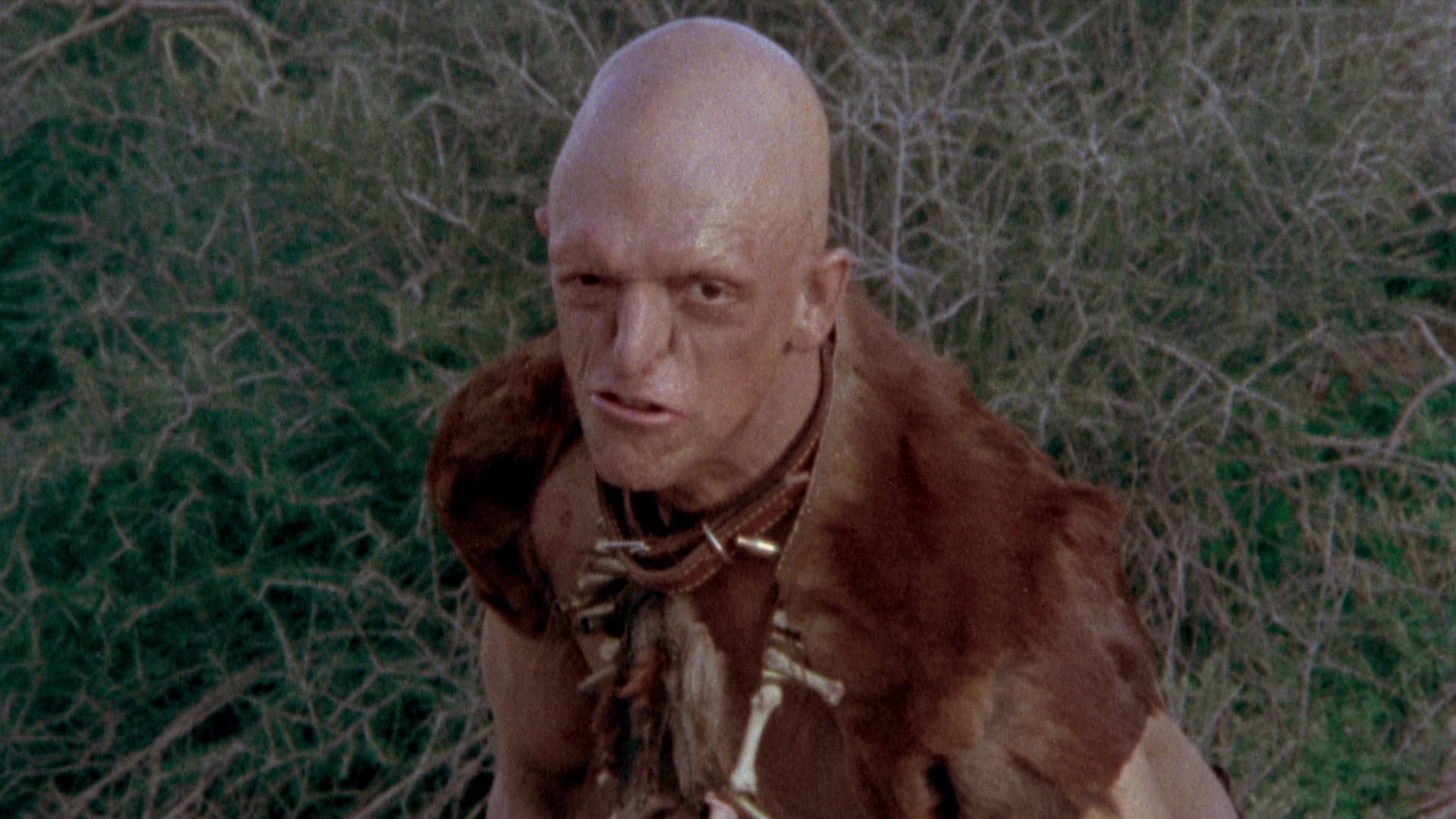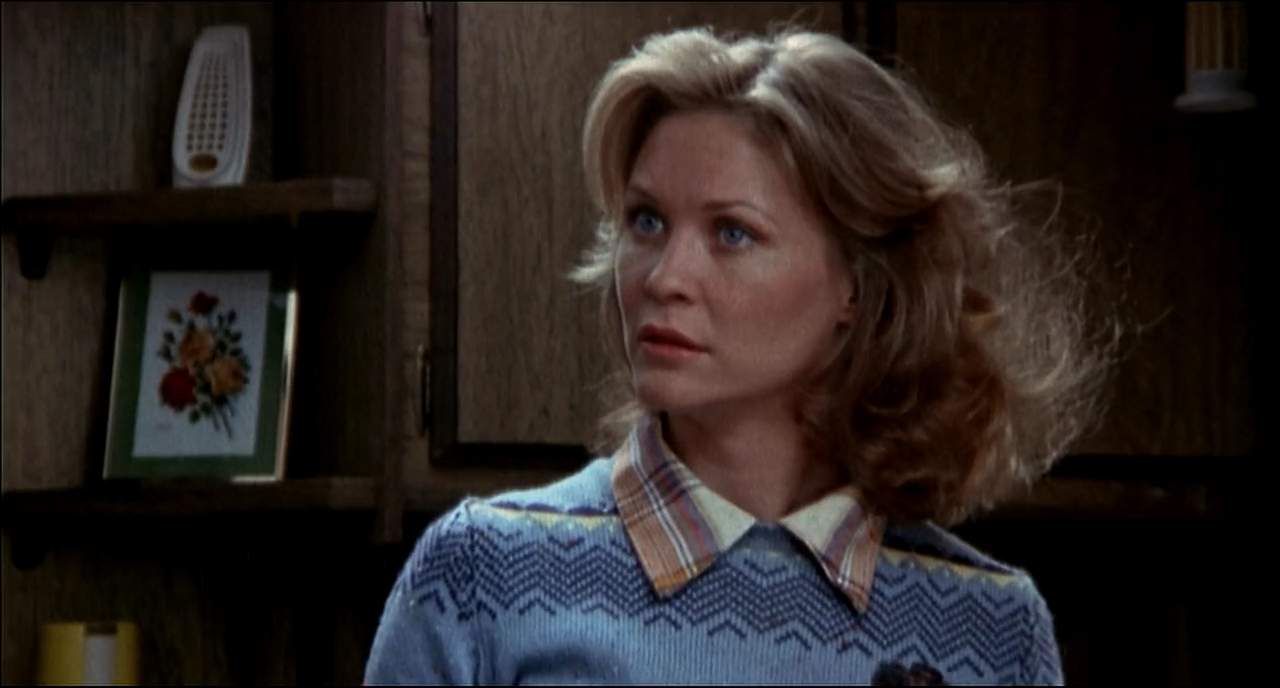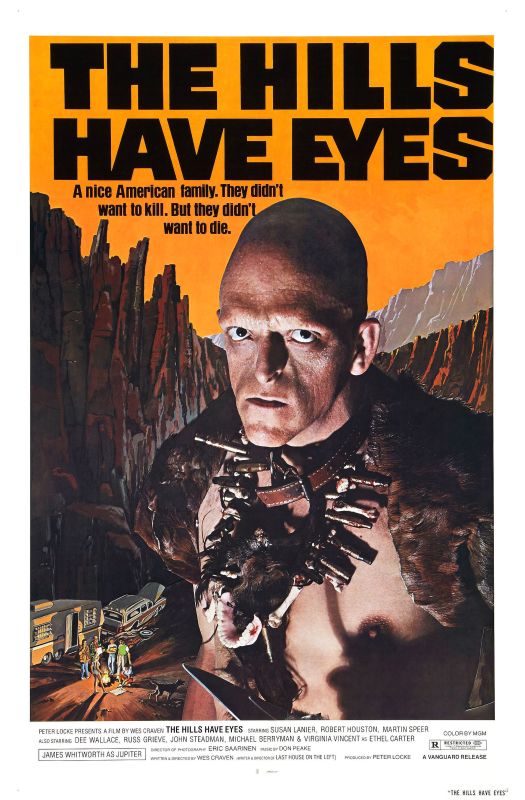Crew
Director/Screenplay – Wes Craven, Producer – Peter Locke, Photography – Eric Saarinen, Music – Don Peake, Special Effects – Greg Auer & John Frazier, Makeup – Dave Ayres & Ken Horn, Art Direction – Robert Burns. Production Company – Blood Relations Co.
Cast
Robert Houston (Bobby), Martin Speer (Doug), Susan Lanier (Brenda), Dee Wallace (Leith), Virginia Vincent (Mrs Carter), Russ Grieve (Bob Carter), Janus Blythe (Ruby), Michael Berryman (Pluto), James Whitworth (Jupiter), John Steadman (Old Man)
Plot
Retired policeman Bob Carter, his wife, their two daughters and their respective husbands drive out into the Arizona desert to visit the silver mine that Bob has inherited. They are swooped over by Air Force jets, which cause them to drive off the road and break the axle of their campervan. As night closes in, they become the prey of a family of cannibals living in the hills.
Wes Craven made a strong directorial debut with the notoriously violent revenge film The Last House on the Left (1972). The Hills Have Eyes was his follow-up and is a clear effort to make another Last House. With The Hills Have Eyes, Wes Craven has a better budget at hand. He transplants the milieu from upstate New York to the Arizona desert but the story is essentially the same – that of a group of wild killers preying upon a group of innocents and the same reversal wherein the family are reduced to barbarism as they exact a nasty revenge on their attackers.
The Hills Have Eyes also bears the unmistakable influence of the backwoods brutality classic The Texas Chain Saw Massacre (1974), which had become a genre landmark in between the time that Wes Craven made Last House and The Hills Have Eyes – with Craven borrowing Texas Chain Saw‘s theme of the group of innocents straying into the domain of crazed backwoods family who survive by preying on others (although Wes Craven does claim to have based The Hills Have Eyes on the legend of the 15th-16th Century Scottish Sawney Beane clan).
That said, The Hills Have Eyes remains a little too much in the shadow of either The Last House on the Left or The Texas Chain Saw Massacre. It lacks the sheer savagery of Last House‘s revenge scenes or the wild all-out intensity of The Texas Chain Saw Massacre. Wes Craven certainly generates a reasonable tension, agoraphobically constricting the film to a single stretch of road. However, the film loses atmosphere when it gets to the scenes with the family fighting back and it changes its nature from a primal attack film into more of an action piece. It becomes repetitive in all the runnings from Point A to Point B and back again.


Moreover, the family’s descent into barbarism and the savagery of their revenge is a much more muted theme than it was in The Last House on the Left. There is certainly the sense of a conservative family – the father is a harsh authoritarian, a traditional Christian and a racist – being brutalised and torn apart, and some nastiness – people being dragged along attached to the wheels of a car, being blown up inside the campervan, and the final freeze-frame on a stabbing. On the other hand, The Hills Have Eyes lacks the vicious irony of Last House‘s ending where the justice exacted by the family became more vicious than the original attacks.
The Hills Have Eyes was also notable for introducing to screens the bald-headed Michael Berryman who has since lent his bizarre presence to a number of genre films. The most notable name to emerge from the cast was Dee Wallace who would later go onto roles in The Howling (1981), Critters (1986) and of course as the mom in E.T. – The Extra-Terrestrial (1982).
Wes Craven made a disappointingly poor sequel The Hills Have Eyes Part II (1985). The Craven-produced Mind Ripper (1995) purportedly started out as a third Hills Have Eyes film. This film was later remade as The Hills Have Eyes (2006), which in turn produced its own sequel The Hills Have Eyes II (2007).
Wes Craven’s other genre films are Summer of Fear/Stranger in Our House (1978), Deadly Blessing (1981), Swamp Thing (1982), Invitation to Hell (tv movie, 1984), A Nightmare on Elm Street (1984), Chiller (tv movie, 1985), Deadly Friend (1986), The Serpent and the Rainbow (1988), Shocker (1989), Night Visions (tv movie, 1990), The People Under the Stairs (1991), Wes Craven’s New Nightmare (1994), Vampire in Brooklyn (1995), Scream (1996) Scream 2 (1997), Scream 3 (2000), Cursed (2005), My Soul to Take (2010) and Scre4m/Scream 4 (2011). Wes Craven has also written the scripts for A Nightmare on Elm Street III: The Dream Warriors (1987), Pulse (2006) and The Hills Have Eyes II, and produced Wishmaster (1997), Carnival of Souls (1998), Don’t Look Down (1998), Dracula 2000 (2000), Feast (2006), The Breed (2006), The Hills Have Eyes (2006), The Last House on the Left (2009), The Girl in the Photographs (2015) and the tv series Scream: The Series (2015-9). He also created the tv series The People Next Door (1989) and Nightmare Cafe (1992).
Trailer here


